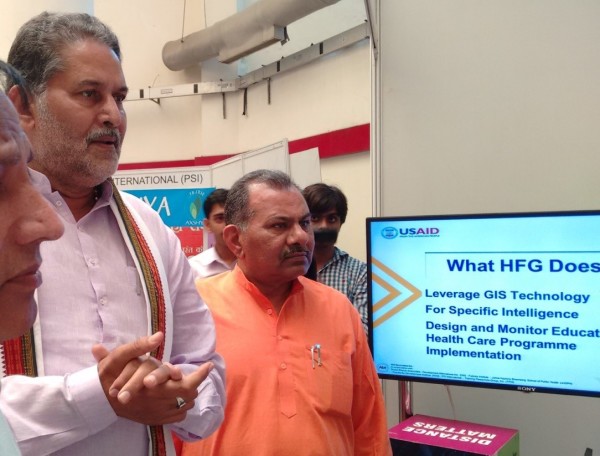HFG Participates in Launch of India’s Campaign to Improve Girls Lives
Categories: Announcements

Extreme left: Shri Rambilas Sharma, Education & Language Minister, Haryana, visits the HFG stall at the launch event.
On July 21, 2015, HFG was invited to share its achievements at a “call to action” launch event for the Indian government’s Beti Bachao, Beti Padhao (“save the girl, educate the girl”) campaign. Beti Bachao, Beti Padhao is a national effort launched by Indian Prime Minister Shri Narendra Modi which seeks to prevent sex-selective abortion, promote the health of girls under-five, and empower girls through access to education.
The launch took place in Haryana state, where HFG is working with the state government to strengthen human resource management and health information systems. HFG is helping to improve the lives of girls in Haryana by incentivizing local health workers to increase access to—and quality of—family planning, reproductive services, and infant and child care.
Stakeholders in attendance included Haryana state’s chief executive, The Honorable Manohar Lal; U.S. Ambassador to India, Mr. Richard Verma; Haryana’s Minister for Women and Child Development, Kavita Jain; and representatives from local and international organizations, NGOs, and businesses. Ambassador Verma referenced HFG’s work as an example of how the U.S. government is aiding the initiative: “In Haryana, we’ve supported the Health Management Information System (HMIS), which monitors reproductive, maternal, and child health indicators, and helps reduce gender disparities in health coverage across the state. Based on its success here, the initiative is now being scaled up in other states.”
HFG’s work in assessing health data quality to inform the HMIS will help to ensure that health authorities in Haryana state have accurate information on girl’s health and access to services, and areas for improvement. The project will also work with the Indian government to assess health system data nationwide, thus allowing health officials at the national level to monitor—and improve—access to health services throughout India.



